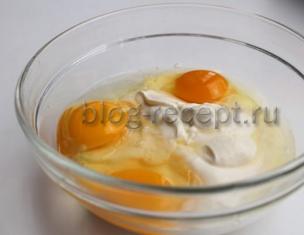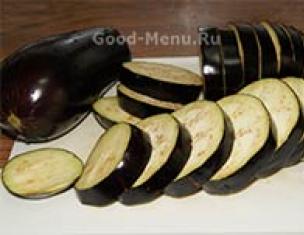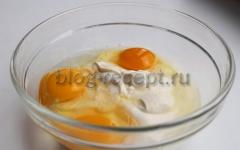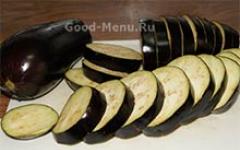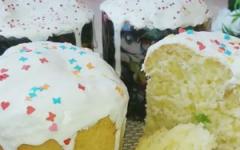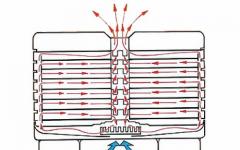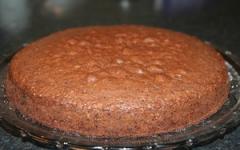About 4 hours of time, a little patience and a great mood: that’s all you need to succeed with this yeasty beauty.
Bake holiday cakes with feeling, wisely, and with care. This is a wonderful tradition for the whole family. And be sure to involve the children. Tell them about customs, church and family. Include fun facts from history and find the country of the next recipe on the map. Share stories from your childhood. And don’t forget about the portraits of satisfied tasters and close-up photos of masterpieces. Let the cozy days and joint culinary successes remain in your memory forever!
Easter Panettone cake from Italy
In search of the most delicious recipe for Easter cake, let's turn to the experience of Italy. Using classic cupcake technology, it’s easy to get a fragrant and fluffy result.
Cooking time - 4-4.5 hours
The ingredients are simple:
- Flour - 500 g
- Salt - one pinch
- Yeast (dry) - 7 g
- Milk - 250 ml
- Egg yolks - 5 pieces
- Butter - 200 g
- Sugar - 100 g
- Lemon zest - from one fruit
- Raisins - 150 g
- Candied fruits - 150 g (optional)
For the glaze:
- Egg white - 1 piece
- Powdered sugar - 100 g
- Lemon juice - 1 teaspoon
- Sprinkles for decoration - to taste
How to make an overseas delicacy step by step with photos.
How to prepare the dough - 3 hours.
Sift the flour. Pour salt and a packet of dry yeast into it and mix thoroughly. Add milk heated to 40°C, 4 yolks and softened butter. The final chord comes from the zest of one lemon. Knead the dough, achieving maximum homogeneity.
Grease a deep bowl with vegetable oil and transfer the dough into it. Cover with cling film and send to a warm place to rise. You can use an oven preheated to 50°C. We’ll also put a small container of water there for optimal humidity. The process is not fast: you need not disturb the workpiece for about 2 hours.
Rinse the raisins in a colander and place the berries on a napkin to absorb excess moisture.
The dough has risen: it has become fluffy and increased in volume. Lubricate your hands with vegetable oil, knead the viscous mass and stir in the raisins. Want maximum sweetness? Then don't forget about an extra portion of candied fruits.



How to form Easter cakes.
Take the dough in portions, roll them into balls and fill the baking pans to 1/3 of the height. Place the molds in a warm oven - 50°C. At the same time, a bowl of water remains in it - for water vapor). Let stand for 45 minutes.



The last stage is baking.
And here are the Easter eggs - in a preheated oven. After the first 15 minutes at 200°C, reduce the temperature to 180°C and wait for final readiness. For small Easter cakes - 30-40 minutes. For large ones - up to 1 hour. A match or a wooden stick will help you not to miss the treasured moment. Cover the still hot cakes for 5 minutes with a damp paper napkin and a towel.
How to make glaze on whites.
Beat the mixture of egg white, powdered sugar and lemon juice. We achieve the correct consistency - fluid and shiny. Grease warm Easter cakes with thick foam, sprinkle with sprinkles, and let cool completely. A miracle treat for everyone's joy is ready!




Cottage cheese cake with yeast
There is no such thing as too much cottage cheese! If you agree, then this recipe is just for you. Tender, fragrant, melt-in-your-mouth butter cakes (or a wide cake if baked in a regular pan).
Cooking time: about 3.5 hours + let cool
Ingredients:
- Cottage cheese - 250 g
- Flour - 400 g
- Dry yeast - 10 g
- Eggs - 2 pcs.
- Butter (softened) - 100 g
- Water (warm) - 50 ml
- Sugar - 125 g
- Vanilla sugar - 10 g
- Salt - ¼ teaspoon
- Raisins and candied fruits - 100 g
For the glaze:
- Protein - 1 pc.
- Powdered sugar - 100 g
- Lemon juice - ¼ teaspoon
Prepare the yeast.
Combine yeast, 1 teaspoon of sugar and flour (2 teaspoons) in a small cup. Fill with water, stir until smooth, cover with cling film and place in a warm place for 10 minutes. If there is no heating anymore and the air in the room is cold: fill a deep bowl of warm water and place the cup in an improvised pool.
Mix the dough.
Finely rub the cottage cheese. An immersion blender or sieve will help with this. Add salt and both types of sugar. Add eggs and butter. Beat thoroughly until the mass becomes pleasantly smooth. We combine activated yeast with it, beat the semi-finished product again with a spatula and gradually add flour. The best way is to sift the flour through a sieve directly into the container.
Has the dough become sticky? You need to start kneading. Sprinkle the surface of the table with flour, lay out the semi-finished product and get to work! Or we turn to the help of a food processor.
Place the finished dough - still slightly sticky to the touch - in a bowl and cover with film. Place in a warm place and wait until the volume of the mass increases 2 times. It will take 1.5-2 hours.

We fill and form the cakes.
Wash the raisins and dry them on a paper towel. Cut the candied fruits into similar sizes. Lubricate your palms with vegetable oil - this way the dough will not stick - and mix the filling into the dough base.
We divide the mass into parts (we have four of them) and turn each of them into a ball. At the same time, we try to ensure that the raisins and candied fruits are hidden inside. Place the balls in greased paper molds - 2/3 full.
Bake and decorate.
Do you want to put the pans in the oven right away? En, no, the best option is to wait a little longer. Place the molds on a baking sheet and cover them with cling film. And only when the Easter cakes have risen to the full height of the container, do we move on to baking - place the baking sheet in an oven preheated to 190°C. Bake until the stick inserted into the Easter cake is dry - 25-30 minutes.
Learn the equation for decoration even in first grade! :) Egg white + powder + lemon juice = glaze. Beat with a mixer until a viscous, solidified syrup is formed. In it we will collapse the top of each Easter cake. A little sprinkle: beauty on the table!
Cupcake Kraffin for Easter - video
This masterpiece is unique and rightfully competes for the title of “the most delicious yeast dough recipe.” The author of the video combined in one process a rich base and the principle of molding, like the famous hybrid of a muffin and a croissant.
Unicorn in the world of desserts!
It is distinguished by its delicate flakiness and twisted character. And it's surprisingly easy to prepare. There are three fun molding steps to add:
- We twist the rolled out layers of dough;
- Cut the “sausages” in half lengthwise;
- We place the resulting strips in a spiral into the molds.
All stages of mastery are below - in an explanatory video with close-ups. Decide on fun chores with a light heart! We have already checked: everything works out the first time. A clear story from a skilled housewife helps a lot.
We need:
- Wheat flour - 350 g flour
- Milk - 80 ml (+30 ml if passion fruit/orange juice is not used)
- Dry yeast - 6 g
- Sugar - 80 g sugar
- Salt - ½ teaspoon
- Egg - 1 pc. + 2 yolks
- Butter - melt 40 g + for layering the dough 100 g at room temperature
- Passion fruit or orange juice - 30 ml (or replace with milk)
- Dried cranberries (or blueberries, raisins, candied fruits) - 100 g
- Crushed nuts - 50 g
- Nutmeg - optional
- Also suitable as a flavoring: lemon zest, orange zest, vanilla
Easter cake with baked milk
Do you like when baked goods are very fluffy and fragrant? Then don't miss the unique baked milk cake - delight in every bite!
Cooking time: overnight + about 1 hour in the morning
To prepare the yeast the night before:
- Sugar - 100 g
- Baked milk (warm) - 125 ml
- Raisins - 50 g
- Yolks (chicken) - 2 pcs.
- Protein (chicken) - 1 pc.
- Butter (soft) - 80 g
- Dry yeast - 1 teaspoon
For dough made from yeast dough (after 8-12 hours):
- Flour - 250-300 g
- Vanilla sugar - ½ teaspoon
- Salt - a pinch
- Cognac - 1 tbsp. spoon
For the glaze:
- Protein - 1 pc.
- Powdered sugar - 100 g
- Lemon juice - ¼ teaspoon
In the evening we will conjure with yeast.
Pour 2 yolks and 1 white into the cup (we will use the other a little later). Add sugar and butter, stir, add pre-washed and dried raisins. We use the whisk again. We dilute the yeast in heated (up to 30-35°C) milk. Pour the solution into the egg-sugar mixture. Mix well, cover with cling film, and leave in a warm place for 8-12 hours. It is best to prepare the yeast base in the evening.
In the morning we will knead the dough.
Are you awake? Have you washed your face? Let's go to the kitchen. It's just a matter of little things: add salt, vanilla sugar and 1 tablespoon of cognac for a refined aroma. Little by little - with a spoon or through a sieve - add flour, achieving maximum smoothness of the mixture. We put the tool aside and start working with our hands. You need to knead the dough for quite a long time - 10+ minutes. But the result will be excellent: you will lick your fingers!
Bake and decorate immediately.
Grease paper molds with vegetable oil. We lay out the workpiece on them - up to ½ of the height. We repeat the already familiar trick with the baking sheet: place the molds covered with cling film on it and give them 1 hour so that the dough rises away from destructive drafts.
Have the Easter cakes grown up? It's time to preheat the oven to 200°C and bake lush deliciousness in it. On high heat it doesn’t last long - only 10 minutes. Then reduce the heat to 180°C for another 30-40 minutes.
We make the protein glaze using a proven technology with lemon juice. Coat the tops of the baked goods with it. You can delight your family with the completed beauty!


“Easter wreath” - step by step with photos
Who said Easter baked goods have to come in just one form? Don't be afraid to create and experiment! To spark your inspiration, we offer you this unusual wreath. For the holiday - in a festive way!
Cooking time: about 5 hours + 3 hours cooling
We will need:
For the test:
- Milk - 150 g
- Flour - 310 g
- Egg - 1 piece
- Butter - 30 g
- Dry yeast - 4 g (pressed - 12 g)
- Sugar - 50 g
- Salt - 5 g
For filling:
- Sugar - 75 g
- Butter (soften!) - 60 g
- Egg - half
- Walnut - 250 g
- Milk - 60 g
- Cocoa - 1 teaspoon
- Cinnamon - ½ teaspoon

We create with attention to detail! :)
Prepare the pastry - 2+ hours.
Dissolve the yeast in warm (35-37°C) milk and wait for the fluffy cap to appear.
We connect the main components. Take 1 tbsp into a separate cup. a heaped spoonful of flour - for kneading. Add salt to the rest of the quantity. Mix and make a hole. Into this ravine we will pour an egg beaten in a deep bowl with sugar, followed by yeast milk. Stir and add butter (softened!). We begin kneading - on a table sprinkled with a set aside spoon of flour.
Is the flour incorporated completely, but the dough is still sticky? That's how it should be. Lubricate your palms with vegetable oil and continue working. Soon the unnecessary stickiness will disappear. Place the confectionery mixture in a deep bowl, greased with oil, and cover the top with cling film. Place in a warm place for 70-80 minutes. We take it out, knead it - from the edge to the center - and again set it to warm up according to the already tested procedure - for 40-50 minutes.




Let's prepare the filling.
Grind walnuts in a blender. This needs to be done wisely and with restraint: we need small pieces, but not nut dust. Add sugar, cinnamon, cocoa. Pour milk into a saucepan. Add butter to it and let it boil. Pour into the nut mixture. Beat the egg - half of the egg mixture will go to the nuts. Mix.



The penultimate stage is the meeting of dough and filling.
Roll out the dough mass to a thickness of 1-2 mm on a large linen or cotton towel. You can just do it on the table. You will get a rectangle - approximately 50 by 45 centimeters. We put the filling on it. It is better to do this with a spoon - so that an empty field 2-3 cm wide remains on one of the edges. Roll the roll, moving from the opposite side to the empty space. We moisten with water and close the seam at the edge of the tube.


The final work is baking.
Place the roll in the mold. Using the technology already familiar to you, put it in a warm oven with a glass of hot water for 70-80 minutes. The workpiece will almost double in size - it’s time to trust the heat. Place the Easter cake in an oven preheated to 170°C and bake for 30 to 50 minutes. As always, we check readiness with a wooden stick.
let's save up
Let the form cool. We remove it and wait for the cake itself to cool down. It will take at least 3 hours. Sprinkle the handsome man with powdered sugar or spread icing. The look is exquisite, the taste is amazing!


Delicious Easter cake without yeast: recipes with photos
In a hurry, but no worse than rich masterpieces! This is how we will prepare several amazing muffin cakes in just 1-1.5 hours. What would you like to put on the table?
- Do you like popular pastries with cottage cheese and raisins in the traditions of our grandmothers? Please!
- Have you decided to please your family with bright sweets? There is also this option - with dates, cinnamon and sour cream dough.
- Are you drawn to unexpected solutions with fruits? Bake the third delicious cupcake - with banana.
- And the sunniest, perhaps, is the fourth - with corn flour and cream.
How to make cottage cheese cake without yeast
Special yeast-free recipe with cottage cheese: get the most out of your holiday without much hassle!
Cooking time - about 1 hour
Ingredients for 4 pieces:
- Cottage cheese - 450 g
- Flour - 450 g
- Butter - 150 g
- Eggs - 5 pcs.
- Sugar - 400 g
- Powdered sugar - 100 g
- Raisins - 100 g
- Baking powder - 12 g
- Vanillin - 1.5 g
- Citric acid - 1/4 tsp.
- Salt - a pinch
- Confectionery topping - optional
We bake quickly and ingeniously simply!

Preparatory stage: curd dough.
Pour the cottage cheese into a blender and grind to a soft and velvety consistency. Whisk a mixture of 4 whites and 5 yolks.
Add sugar and vanillin to the cottage cheese, pour in the beaten eggs and melted butter and mix. First we work with a spoon, and then with a whisk.
Add flour and baking powder little by little. Remember that after each small portion, the future dough must be mixed thoroughly. Add the raisins and mix the mixture well.
Distribute into molds and bake.
Grease paper molds with vegetable oil, place the sticky semi-finished product inside - about ½ of the way up. Place in a preheated oven - 180°C. You won't have to wait long - 35-40 minutes.
We are sure that you immediately solved the riddle of our detective: where will squirrel No. 5 go? Beat it with powdered sugar and citric acid. Coat the cakes with gooey glaze and decorate with sprinkles. So we have conquered another recipe among the most delicious!
Cupcake for Easter with dried fruits: recipe with photos step by step
Are you yearning for fruity notes? Then this option is just for you. Candied fruits, dates, cherries - here it is, the sweet optimism of the great holidays!
Cooking time - 1 hour 15 minutes
We need:
- Eggs - 4 pieces
- Flour - 350 g
- Sour cream (fat, 20%) - 200 g
- Butter - 120 g
- Baking powder for dough - 1 teaspoon + slide
- Soda - 0.5 teaspoon
- Sugar - 150 g
- Sugar (vanilla) - 1 tbsp. spoon
- Cinnamon - 0.5 teaspoon
- Candied fruits (for example, pineapple and papaya) - 100 g
- Cherries or cranberries (dried) - 100 g
- Dates - 5-7 pieces
- Zest (lemon or orange) - 1 teaspoon
The trip to the south will be simple and pleasant. :)
Let's make the dough.
Mix both types of sugar and butter (previously softened). We begin to beat the mass in a mixer, adding eggs along the way. Take your time and don't type everything in at once! Add one, wait until the mixture is smooth, and only then use the next.
The mixer continues to work, and we add cinnamon, pour in sour cream, add citrus zest, and - slowly, spoon by spoon! - add flour. We increase the volume and fluffiness: after the first 3-4 tablespoons of flour, it’s the turn of soda and baking powder (mix together).
When the mixer can no longer cope with the dough, add the rest of the flour in portions and knead the dough by hand. At the end, add the filling to your taste: cherries or cranberries, finely chopped dates, candied fruits.




Bake and decorate.
Grease the mold with oil and place the dough on it. Preheat the oven to 200°C and place the semi-finished product in it - 45-50 minutes. We check final readiness with the help of an eternal kitchen companion - a match or a toothpick. Sprinkle with powdered sugar and decorate as desired. What a cute holiday it would be with such and such baked goods!



Easter Banana Cake
Have you already read it? Here's another wonderful property of a tropical fruit: when baking with it, it's easy to do without yeast. Want to know how? Read the preparation step by step - we will reveal all the secrets!
Cooking time - 1 hour 10 minutes
Ingredients:
- Flour - 1.5 cups
- Sugar - 1 glass
- Bananas - 2 pcs.
- Eggs - 2 pcs.
- Water - 1 tbsp. spoon
- Butter - 75 g
- Soda - 1 teaspoon
- Baking powder - ¼ teaspoon
- Salt - 1 pinch
- Raisins and candied fruits - 30 g (about 1 tablespoon)
Let's go south! :)

How to make mashed banana dough.
We take the mixer: with it we will beat the butter that has had time to soften, while simultaneously pouring in sugar and salt (and also, if desired, a pinch of vanillin). Beat two eggs into the dough and turn on the mixer again until the consistency becomes thick and viscous.
Now it's the turn of bananas. Peel them, break them into pieces and throw them into the blender bowl. Whip, whack – we have mashed bananas! Pour a tablespoon of water into it so that the crushed pulp becomes more liquid. Stir and combine this fruit dressing with the already whipped dough base. Mix again.
The third stage is for dry ingredients. Combine flour, baking powder, soda. Little by little, in portions, pour the mixture into the liquid base. Turn on the mixer at low speed and achieve a uniform consistency. Properly prepared dough will be elastic, but not too tight.
How to bake the most delicious cupcakes for Easter.
At the end, stir in raisins and candied fruits. We distribute the dough among paper forms - half the height or a little more. Place the molds in a preheated oven - 190°C. There the Easter cakes will have to stand for about 40 minutes. Is the test wooden stick dry? All is ready!
Cover with glaze and delight your friends and family! Well, isn't banana the king of fruits?
Easter cake made with cream and corn flour
Has the cottage cheese become boring? What about sun corn? No yeast, everything is simple to the point of genius, fast and clear. One, two, three... Let's go!
Cooking time - 1 hour 30 minutes
- Flour (wheat) - 200 g
- Flour (corn) - 250 g
- Eggs - 6 medium
- Butter (butter) - 300 g
- Cream (from 10 to 30%) - 200 g
- Orange - 1 medium
- Raisins - 100 g
- Candied fruits - 200 g
- Powdered sugar - 200 g
- Vanillin - 2 g
- Baking powder - 20 g
- Salt - 1 pinch
Enjoy the step-by-step process with photos. :)
How to make the dough.
Carefully remove the peel from the orange: we will need it later. Squeeze the juice and separate the egg whites from the yolks. Mix the dry products: both types of flour, vanillin and baking powder. It is important that the mixture is as homogeneous and airy as possible. To do this, you should sift it 1-2 times.
Let the butter soften. We begin to beat it with a mixer. The foam has become light and voluminous - add powdered sugar. It is followed, strictly one at a time, by the yolks. The next ones are orange zest and juice. Lastly - dry mixture and cream. Don't let the mixer rest! The more evenly we mix everything, the tastier the result will be.
Has the dough become thick and sticky, too much for the mixer to handle? We work with our hands or trust the work to a food processor. Add candied fruits and raisins and mix the mixture so that they are distributed evenly throughout the entire volume.
Beat lightly salted whites. First we work at low and then at higher mixer speeds. Add foam to the dough and continue kneading until completely homogeneous.
How to bake Easter cakes.
Place the mixture in paper molds 2/3 of the way up. Place in an oven preheated to 180°C. We wait 1 hour, checking readiness with a toothpick. Decorate with icing and sprinkles. Oh, and how tender the corn shells turned out! Real jam!



Egg white glaze is a #1 classic. And classic No. 2 is the gelatin version. Smooth, shiny and strong: it doesn’t crumble and grips the sprinkles perfectly. How to make a gelatin miracle is shown in the video below.
How to store Easter cakes so they don’t go stale for a long time.
There are several life hacks.
- The easy way. Cool well and place in a plastic bag, wrapping it tightly, releasing all the air.
- Grandmother's secrets - light linen fabric or clean white paper. Wrap and place in a cool place.
- The third trick is a large saucepan with a tight-fitting lid. In such a house, cupcakes will remain fresh for up to a week. The best company is in a closed container where Easter cakes are stored - a couple of pieces of refined sugar, apple slices or potatoes without skin.

Calories: Not specified
Cooking time: Not indicated
For the Bright Holiday, all housewives bake airy Easter cakes, Easter gingerbread cookies, cookies, and wreaths. Every home is filled with all kinds of snacks, meat and fish dishes, desserts, and incredibly aromatic pastries. I suggest you bake Easter cupcakes, and my recipe with photos will help you with this. You can easily prepare juicy, appetizing and very attractive cupcakes, since in general, cooking does not require a lot of time and expensive ingredients. You can decorate the finished baked goods to your taste.
This amount of ingredients makes 12 cupcakes.
Required ingredients:
- wheat flour - 300 g,
- butter - 150 g,
- chicken egg - 3 pcs.,
- vanilla sugar - 10 g,
- baking powder - 1 sachet (18 g),
- raisins - 100 g.
Glaze:
- chicken protein - 1 pc.,
- powdered sugar - 200 g,
- food colorings,
- lemon juice - 1 tbsp.,
- candies for decoration.
Recipe with photos step by step:

All foods for cooking should be at room temperature. In a deep bowl, combine chicken eggs, granulated sugar and vanilla sugar. Take a hand whisk or mixer and beat, not too much, until smooth. 
First, melt the butter or margarine, cool slightly and add to the egg mixture. Continue stirring until smooth. 
Sift the flour into a separate container. Add baking powder and stir. Add the flour mixture to the rest of the ingredients and mix well into the dough so that there are no lumps. 
Add raisins, stir until they are evenly distributed throughout the dough. If the raisins are too dry, pour boiling water in advance for 10-15 minutes, then drain the water and dry well. Sprinkle lightly with flour. The dough turns out quite thick. If you have too much flour, you can add a little milk. 
Divide the dough into the molds, filling approximately 2/3 of the mold. It is convenient to use silicone or iron ones together with paper ones. Place in a preheated oven for 30-50 minutes at 180 degrees. 
Place the finished muffins on a wire rack and cool well. 
In the meantime, let's prepare the glaze. Beat the chilled egg white with a pinch of salt until foam appears, at low speed. You can beat with a mixer or a hand whisk. 
To cover the cupcakes you will need a not very thick glaze. Add powdered sugar. If the white powder is large, it may take about 180-200 g. In another case, approximately 150-180 g. 
Add powder in small portions to form a mass similar to liquid sour cream. Pour in lemon juice and mix well. 
To make drawings on white glaze, you will need a thicker mass. Select the required amount of white icing, add a drop of dye, and mix. 
Add powdered sugar to make the mass more stable and not spread when drawing. 
Grab the bottom of the cupcake and dip into the white frosting. Top with colorful candies. Leave for 25-30 minutes for the glaze to dry. 
Now transfer the colored icing into a piping bag with a small hole and pipe the designs you want. Let it dry. 

Delicious and juicy Easter cupcakes are ready. Happy holiday and delicious desserts to you!
We also invite you to look
For many centuries, before the Easter holiday, the tradition of painting eggs, baking Easter cakes and cooking has been preserved. Easter cakes, or kollikion from Greek - round bread is baked with prayers and pure thoughts. Every housewife cleans her house for the holiday and starts baking in a clean apron or apron. If baking is successful, then there is peace and prosperity in the house, this is an old sign. The prepared Easter cakes were never cut vertically, but after cutting off the top decorated with a cross, they were set aside, and then the remaining Easter cake was covered again and eaten, only lastly, in the end, as the most delicious part with special reverence. It seems that now the easiest way is to buy ready-made Easter cakes in stores, since there is a great variety of them. But, nevertheless, I wish every housewife to bake her own Easter cake, you will see how joyful you will be at this time and when you treat everyone to your amazing cake. And you can decorate it, embodying all your imagination and invention.

Easter cakes and muffins can now be bought without any problems in any baked goods department, but store-bought ones are not as tasty and not as elegant. In addition, it will always be a joy to bake a beautiful and tasty cake yourself, and preferably several at once. After all, this bright holiday should be generous and hospitable. It’s a pleasure for the family and a treat for the guests. So, choose the recipe that suits you best, and having prepared everything you need, we begin to cook. Let's put the dough:
Recipe: take 1 tablespoon of flour, 200 gr. yeast (wet in a briquette), a little sugar, warm milk (150ml), separate 20 yolks from the whites. Mix the yolks into the flour. Milk, sugar, sour cream, raisins (pre-fill them with boiling water, drain, squeeze and roll in flour). Add vanilla sugar, salt, lemon zest to the flour. Knead everything well with your hands, but you can also use a mixer or dough mixer. The dough is kneaded well and lags behind the walls of the dish. Place the prepared dough into a large, voluminous bowl to rise. Cover with cling film and leave for 40 minutes in a warm place. This process may take a little longer. Then, knead the dough and place it in prepared molds, which are pre-greased from the inside with oil. Leave for 40 minutes to rise, brush with beaten egg and place in a preheated oven at 180 C, bake until done, check with a wooden stick to be sure.
Important: While the dough is rising, mix the yolks with a spoon of sugar. Heat the milk so that it is warm, melt the butter, sugar and vanillin, grated zest in it. Soak the raisins for 10 minutes.
Ingredients: calculated for 3 kg of flour - 20 yolks, 750 g butter, 1 kg 200 g sugar, 600 g raisins, vanilla (bag), 1 teaspoon salt, 4 lemons (zest), 200 g yeast, 1 liter 200 ml - milk. You can take half as much. Place the dough in a warm place for 20-30 minutes! The Easter cakes turn out very tasty.

You will need for the recipe: Milk 250 ml, cream (15-20%) 200 ml, sugar 285 g, 5 eggs, butter 150 g, vegetable oil 50 g, fresh yeast 40 g (I have 3.5 tsp dry), a bag of vanilla sugar, flour 700-1000 g, salt 1 tsp.
I also added candied fruits, zest, freshly ground cardamom and nutmeg. Heat the milk slightly, approximately 35 degrees C, separate 50 ml from the total amount and dissolve the yeast and 1 tablespoon in it. spoon of sugar. Bring the rest of the milk to a boil. Gently add flour, stir so that there are no lumps. Heat the cream and pour it into the custard milk mass. Mix everything well and leave to cool to room temperature. add the appropriate yeast to them and mix everything. Place the dough in a warm place.

This recipe makes amazing Easter cakes: tender, soft, fragrant! To make them look like this, you need the freshest products: sour cream, eggs, yeast, butter and of course, flour. Easter cakes can be baked with milk, cream, kefir, yogurt, fermented baked milk, with or without yeast. We put washed and dried raisins, candied fruits, poppy seeds, and nuts into the dough. You can regulate the amount of products you need. Some people bake a lot of cakes at once, while others won’t need as many. From the specified amount of ingredients, you get 2 Easter cakes 11 cm high and 17 cm wide and 14 small Easter cakes 7 cm high and 6 cm wide.
Ingredients:
300 ml milk, 11 g dry yeast (or 50-60 g raw yeast), 3 eggs, 200 g sugar, 150 g butter, 250 g sour cream (15-20%), vanilla stick (or 2 tsp vanilla sugar), 300 g raisins,
700-800 g flour.
How to prepare the dough:
Heat the milk until it is slightly warm. Add yeast and 1 tsp to milk. Sahara. Pour 200-250 g of sifted flour and mix. Cover with a napkin or towel and place in a warm place. The dough is doubled, it will take 30-40 minutes.
Dough:
Beat eggs with sugar. Cut the vanilla stick and remove the seeds. Add eggs to the dough and mix. Add vanilla seeds (or vanilla sugar). Add softened (not melted) butter and mix. Add sour cream, mix. Pour in the remaining flour (you may need a little more or less flour, it depends on the quality of the flour), knead the dough. The dough must be kneaded well, it should not be stiff and should not stick to your hands. Cover the dough with a napkin or towel and put it in a warm place. The dough should rise well. Add raisins (pre-washed and dried) to the dough. Cover with a napkin or towel and place in a warm place. Let the dough rise well again. Grease the molds a little with oil. We spread the dough, filling the molds to 1/3 of the height of the mold. We wait for the dough to rise slightly in the molds and place in an oven preheated to 100 degrees, bake for 10 minutes. Then increase the temperature to 180 degrees and bake until done (about 30 minutes). As soon as the cake is browned, we check it for readiness; to do this, pierce it with a wooden skewer (or toothpick); if it is dry, the cake is ready. Decorate to taste. You can grease the top and sides with protein cream and decorate with confectionery sprinkles.
Many people ask the question: How to prevent the glaze fromcrumbled and your efforts were not in vain, useful advice: Add 1 teaspoon of instant gelatin with 2 tablespoons of water and leave to swell for 5-10 minutes. Pour 1 glass of sugar (+ vanillin) into 4 tablespoons of water and place on low heat, stirring until dissolved. There is no need to bring the syrup to a boil; it is important that only the sugar dissolves. If the sugar has not yet dissolved, then boil the syrup until the sugar is completely dissolved, otherwise the glaze will turn out grainy. Add the swollen gelatin to the sugar syrup, mix and beat with a mixer until the mass turns white and becomes fluffy. Add lemon juice. Let the glaze cool a little, but not completely - otherwise it will harden. (If you have super-fast gelatin, it is not always possible to cover all the cakes at once. Place the glaze in a water bath, it will become liquid again, and you can cover the cakes with it again). Now you can safely cut Easter cakes and cupcakes, the delicious glaze will not crumble or crack.
HAPPY AND HAPPY EASTER TO EVERYONE!
Preparation for Easter takes the entire pre-holiday week: housewives paint eggs, prepare Easter cakes, Easter cottage cheese and the most favorite family dishes for breaking the fast. If you don’t want to bother with yeast dough, you can bake Easter cupcakes instead of Easter cakes. Sweet mini-cupcakes with the addition of raisins, dried fruits or candied fruits will save a lot of time, and they are also very convenient to eat - they are served in portions, so the icing will not crumble, as when cutting traditional Easter cakes.
Cupcakes decorated with sugar icing and sprinkles will look very elegant and festive on the table. They are in no way inferior to traditional Easter baked goods in taste; they turn out fluffy and soft, with a pleasant aroma of vanilla and beautiful high tops.
Ingredients for the dough:
- chicken eggs - 2 pcs.;
- butter - 100 g;
- sugar - 200 g;
- salt - 1 chip;
- vanilla - on the tip of a knife;
- 15-20% sour cream - 100 g;
- baking powder for dough - 1.5 tsp;
- raisins - 100 g;
- wheat flour - 200 g.
Ingredients for glaze:
- egg white - 1 pc.;
- powdered sugar - 200 g;
- vanilla sugar - 5 g.
Cooking time: 50 minutes.
Output - 12 pcs.
Easter Cupcakes Recipe
1) Steam the raisins with boiling water, let them swell for 20 minutes (both light and dark seedless raisins are suitable for making Easter cupcakes). Squeeze the raisins from the water, dry them on a towel and roll them in flour so that they do not sink to the bottom of the muffins during baking.

2) Beat the eggs into a deep bowl and add butter, softened at room temperature (no need to melt in a water bath or in the microwave!). Beat with a mixer for 3-4 minutes until smooth. Depending on the quality of the butter and the degree of its softening, it may disperse completely or come together in pieces - no need to worry, it will reach homogeneity after the next step.

3) Add salt, sugar, vanillin, sour cream and baking powder to the butter-egg mixture. Beat with a whisk or mixer for 1-2 minutes until smooth.

4) Gradually add flour, sifting it through a sieve, continuing to work with the mixer (you will need 200 g of flour = 1 high-top glass). The result should be a thick dough, homogeneous and without lumps.

5) Add raisins and very carefully mix the dough with a spoon from top to bottom.

6) Place the dough into molds - it is most convenient to use paper capsules or silicone molds that do not need lubrication (if you use iron molds, grease them with vegetable oil). Fill the molds 2/3 full, leaving room for the dough to grow.

Place in a cold oven (so that the cupcake caps do not crack), set the temperature to 180 degrees and bake for 25-30 minutes. We check the readiness with a wooden toothpick - if it comes out dry from the dough, it means the baked goods are ready.
7) While the cupcakes are cooling, prepare the sugar glaze: beat the chilled egg white until white, but not to peaks, gradually add powdered sugar and vanilla sugar. Cover the caps with glaze using a pastry brush with natural bristles (if you don’t have one, carefully apply the glaze with a teaspoon).



